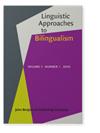Proficient L2 readers do not have a risky reading strategy
IF 1.8
2区 文学
0 LANGUAGE & LINGUISTICS
引用次数: 0
Abstract
Proficient first-language (L1) readers of alphabetic languages that are read left-to-right typically have a perceptual span of 3–4 characters to the left and 14–15 characters to the right of the foveal fixation. Given that second-language (L2) processing requires more cognitive resources, we hypothesize that L2ers will have a smaller perceptual span than L1ers, and may rely on a compensatory risky reading strategy with a more symmetrical perceptual span similar to that seen in older L1 adults. Here, we test the size and symmetry of the perceptual span in German L1/English L2ers reading in English. We manipulate the amount of information available (3,6,9 characters-left/3,9,15 characters-right) during reading, and also account for the influence of English skills. Results show that L2ers benefit from an increase of window size from 3 to 6 characters to the left, and from 3 to 9 characters to the right, with higher-skilled L2ers further benefiting from an increase to 15 characters to the right. Contrary to our hypothesis, proficient L2ers exhibit an asymmetric perceptual span similar to college-aged L1ers and do not employ a compensatory risky reading strategy. This suggests that L1 and L2 language processing are not qualitatively different, but are rather modulated by individual differences.熟练的二语读者不会有冒险的阅读策略
熟练的母语(L1)读者从左到右阅读字母语言时,通常在中央凹固定的左侧有3-4个字符和右侧有14-15个字符的知觉广度。鉴于第二语言(L2)处理需要更多的认知资源,我们假设L2学习者的感知广度比L2学习者小,并且可能依赖于一种补偿性风险阅读策略,这种策略具有更对称的感知广度,类似于老年L1成年人。在这里,我们测试了德语L1/英语l2学生用英语阅读时感知广度的大小和对称性。我们在阅读过程中操纵了可用的信息量(3、6、9个字符向左/3、9、15个字符向右),并考虑了英语技能的影响。结果表明,将窗口大小从左边的3个字符增加到6个字符,从右边的3个字符增加到9个字符,更高技能的l2er进一步受益于将窗口大小增加到右边的15个字符。与我们的假设相反,熟练的2年级学生表现出与大学年龄的1年级学生相似的不对称感知广度,并且不采用补偿性风险阅读策略。这表明,母语和二语的语言处理并没有本质上的差异,而是受到个体差异的调节。
本文章由计算机程序翻译,如有差异,请以英文原文为准。
求助全文
约1分钟内获得全文
求助全文
来源期刊

Linguistic Approaches To Bilingualism
Social Sciences-Linguistics and Language
CiteScore
3.20
自引率
9.10%
发文量
24
期刊介绍:
LAB provides an outlet for cutting-edge, contemporary studies on bilingualism. LAB assumes a broad definition of bilingualism, including: adult L2 acquisition, simultaneous child bilingualism, child L2 acquisition, adult heritage speaker competence, L1 attrition in L2/Ln environments, and adult L3/Ln acquisition. LAB solicits high quality articles of original research assuming any cognitive science approach to understanding the mental representation of bilingual language competence and performance, including cognitive linguistics, emergentism/connectionism, generative theories, psycholinguistic and processing accounts, and covering typical and atypical populations.
 求助内容:
求助内容: 应助结果提醒方式:
应助结果提醒方式:


